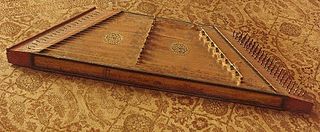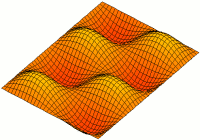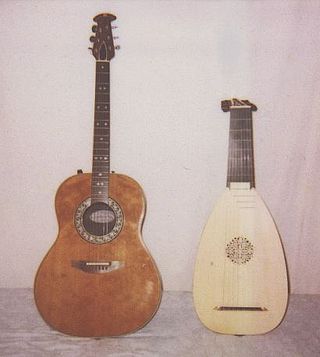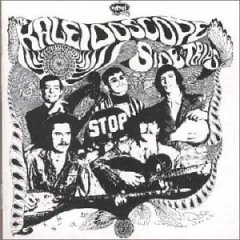Related Research Articles

The word dulcimer refers to two families of musical string instruments.

The hammered dulcimer is a percussion-stringed instrument which consists of strings typically stretched over a trapezoidal resonant sound board. The hammered dulcimer is set before the musician, who in more traditional styles may sit cross-legged on the floor, or in a more modern style may stand or sit at a wooden support with legs. The player holds a small spoon-shaped mallet hammer in each hand to strike the strings. The Graeco-Roman word dulcimer derives from the Latin dulcis (sweet) and the Greek melos (song). The dulcimer, in which the strings are beaten with small hammers, originated from the psaltery, in which the strings are plucked.

The Appalachian dulcimer is a fretted string instrument of the zither family, typically with three or four strings, originally played in the Appalachian region of the United States. The body extends the length of the fingerboard, and its fretting is generally diatonic.

A resonator is a device or system that exhibits resonance or resonant behavior. That is, it naturally oscillates with greater amplitude at some frequencies, called resonant frequencies, than at other frequencies. The oscillations in a resonator can be either electromagnetic or mechanical. Resonators are used to either generate waves of specific frequencies or to select specific frequencies from a signal. Musical instruments use acoustic resonators that produce sound waves of specific tones. Another example is quartz crystals used in electronic devices such as radio transmitters and quartz watches to produce oscillations of very precise frequency.

Jacques Dudon is a French just intonation composer and instrument builder. He is best known for developing a series of photosonic disk instruments in the 1980s that produced sound from modulated light.

Leptonetidae is a family of small spiders adapted to live in dark and moist places such as caves. The family is relatively primitive having diverged around the Middle Jurassic period. They were first described by Eugène Simon in 1890.

A resonator guitar or resophonic guitar is an acoustic guitar that produces sound by conducting string vibrations through the bridge to one or more spun metal cones (resonators), instead of to the guitar's sounding board (top). Resonator guitars were originally designed to be louder than regular acoustic guitars, which were overwhelmed by horns and percussion instruments in dance orchestras. They became prized for their distinctive tone, and found life with bluegrass music and the blues well after electric amplification solved the problem of inadequate volume.

Plucked string instruments are a subcategory of string instruments that are played by plucking the strings. Plucking is a way of pulling and releasing the string in such a way as to give it an impulse that causes the string to vibrate. Plucking can be done with either a finger or a plectrum.
Traditional Vietnamese musical instruments are the musical instruments used in the traditional and classical musics of Vietnam. They comprise a wide range of string, wind, and percussion instruments, used by both the Viet majority as well as the nation's ethnic minorities.
Cawood Ledford was a radio play-by-play announcer for the University of Kentucky basketball and football teams. Ledford's style and professionalism endeared himself to many sports fans in the Commonwealth of Kentucky and he remains among the most popular sports figures in the state.
Homer C. Ledford was an instrument maker and bluegrass musician from Kentucky who specialized in making dulcimers.
A banjo dulcimer is an Appalachian dulcimer modified by adding a vibrating membrane to the body of the instrument. This changes the tone and volume of the instrument, operating on the same principle as the banjo.
The dulcitar is a variant of the Appalachian dulcimer, which retains the dulcimer's diatonic fret layout yet features a long neck that is intended to be played upright in the guitar style rather than flat across the lap. Luthier Homer Ledford coined the word dulcitar as a portmanteau of dulcimer and guitar, building his first model of the instrument around 1971. One of Ledford's dulcitars was accepted into the permanent collection of the Smithsonian Institution, as well as displayed in a traveling exhibit on American craftsmanship.

Side Trips is the debut studio album by American band Kaleidoscope. It was released in May 1967, on Epic Records BN 26304, and re-released on vinyl by Sundazed Records (2007). The album has a raw, non-limited instrumental mentality, for each member played many instruments; for example, David Lindley played guitar, banjo, fiddle, and mandolin, and Solomon Feldthouse played saz, bouzouki, dobro, vina, oud, doumbek, dulcimer, fiddle, guitar, and vocals.

Bing Futch is a musician whose primary instrument is the mountain dulcimer. In 1986 he co-founded Christian techno-punk trio Crazed Bunnyz along with Marc "Gadget" Plainguet and Sean "Shaka" Harrison. He relocated to Orlando, Florida in 1993 and also plays the Native American flute, ukulele, and drums.
Charles E Brasher was a Canadian inventor, and maker of stringed instruments. His inventions include a novel cone for the resonator guitar, which he patented in Canada in 1935..
A resonator is a device or system that naturally oscillates at some frequencies.

Further Down the Old Plank Road is a 2003 album by The Chieftains. It is a collaboration between the Irish band and many top country music musicians including Rosanne Cash, Chet Atkins, The Nitty Gritty Dirt Band, Ricky Skaggs, and Patty Loveless.
References
- ↑ Alvey, R. Gerald. Dulcimer Maker: the craft of Homer Ledford. University Press of Kentucky, 2003. ISBN 978-0-8131-9051-8. Pg 48-51